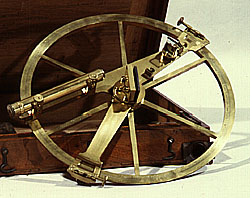 83. Reflecting circle according to Borda by E. Lenoir
83. Reflecting circle according to Borda by E. Lenoir
In the mid-XVIIIth century the German astronomer Johann Tobias Mayer (1723-1762), for better measuring angles, invented this instrument which consisted of a 360° circle used for both navigation and surveying purposes. In 1787 Chevalier de Borda (1733-1799) perfected its design and thus gave his name to this reflecting circle. Edward Troughton (1753-1835) brought further improvements, using three indicator arms with verniers that would allow three readings to be made at three different points.
Etienne Lenoir was the craftsman who put Borda’s inventions into practice, building numerous reflecting and repeating circles and supplying the French state with them for triangulation of the meridian arc between Dunkerke and Barcellona, a measurement that was to help establish the length of the meter (see file 77 on the standard meter of Deleuil).
For more details on the life and work of Lenoir, who in his time was considered the best designer of nautical astronomy and observation instruments, see Daumas and Bennett (op. cit.).
Ceschi’s 1843 inventory describes this exemplar, signed Lenoir a Paris n. 23, as follows:
"Borda reflecting circle, made by Lenoir, one foot in diameter. This circle is graduated in 720 parts, each of which is subdivided in three. The two verniers, which are located, one at the end of the alidade carrying the telescope and small mirror, the other at the end of the alidade of the large mirror, give the twentieth part of the last subdivision of the Circle. This instrument is equipped with:" The inside of the cover of the wooden box which holds it bears some pen markings used for rectifying the instrument.
- An ebony handle, decorated in metal, screwed into the back of the instrument.
- A small magnifying lens for reading the divisions.
- No. 4 differently colored glass shades with metal frames to place in front of the large mirror.
- No. 4 of the said to place between the two mirrors, or at the back of the small mirror.
- No. 5 different metal parts used for rectifying the instrument.
- A screwdriver with ebony handle.
- Another smaller metal one for moving the rectification screws of the two mirrors.
J.A. Bennett (1989).
M. Daumas (1953), pp. 245, 268, 363, fig. 107.
A.J. Turner (1989).
G.L’E. Turner (1991), pp. 242, 453.